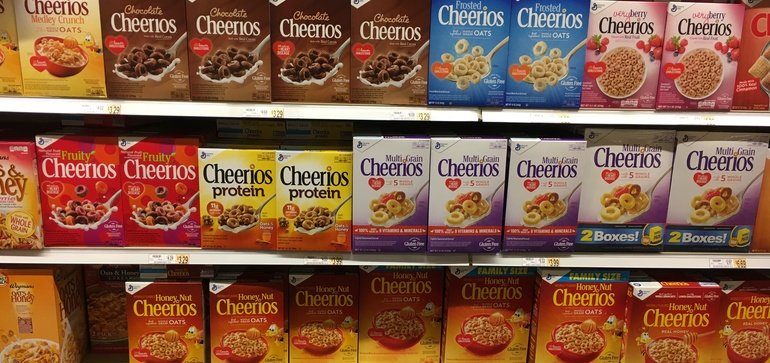General Mills plans to cut up to 1,400 jobs worldwide, Star Tribune reports

Dive Brief:
- General Mills executives told employees last week it plans layoffs of 700 to 800 positions in the U.S. and Canada, and 500 to 600 additional positions worldwide, the Star Tribune reported. At the company’s headquarters outside of Minneapolis, as much as 20% of its 3,000 employees could be cut, the newspaper reported.
- In a filing with the U.S. Securities and Exchanges Commission last week, General Mills said it expects to incur about $160 million in restructuring costs — primarily severance payments — in fiscal year 2021, which ended May 30. By the end of fiscal 2023, the company expects to pay out a total of $170 million to $220 million in the restructuring effort — $130 million to $180 million of which will be cash, the filing says.
- General Mills has been shuffling and dismissing executives in recent weeks as part of its Accelerate growth strategy. In late May, Chairman and CEO Jeff Harmening announced a series of new leadership assignments at an investor conference. These changes created the new positions of chief strategy and growth officer and chief transformation and enterprise services officer, and eliminated the jobs of global chief marketing officer and president of Europe and Australia.
Dive Insight:
With the shakeup at General Mills starting in the c-suite and Harmening mentioning at an investor conference that the changes were “not simply a cost-cutting exercise,” it seemed the biggest unanswered question was when this would trickle down to employees.
The Star Tribune, which is the hometown newspaper of General Mills’ corporate headquarters, drew its reporting from a companywide memo emailed to employees last Tuesday and a virtual company meeting on Friday.
General Mills responded to questions about the layoffs with a brief emailed statement and links to the SEC filing and recording of Harmening talking about the executive shuffling.
“As we shared in our 8-K filing, we are making organizational changes to ensure General Mills continues its momentum,” General Mills spokesperson Kelsey Roemhildt said in an an email. “We are investing in key areas such as digital, data & technology, E-commerce and others that are critical to our future success.”
Harmening had said at an investor conference in February that the Accelerate strategy was devised before the pandemic. It has four pillars: building purpose-driven brands that meet consumers where they are; innovating to create new solutions to consumer problems and get those products to market quickly; using scale to create competitive advantage through data, supply chain efficiency and e-commerce; and working toward environmental and social sustainability. It also allocates large investments and resources to five platforms that represented about 45% of sales last year: cereal, pet food, ice cream, snack bars and Mexican food.
Employees may not have known until recent weeks that the strategy also included job cuts, the Star Tribune reported.
“I know this isn’t easy and that there are real world personal impacts in us making this shift. And last week was especially hard as we shared that reshaping our organization meant that many of our colleagues will be leaving General Mills,” Harmening wrote in last week’s memo, according to the Minneapolis newspaper.
About the job cuts and shuffles, Harmening has said the reorganization is freeing up General Mills’ resources to redeploy them to more growth-facing areas. But there has been nothing obvious in most of the financial records and presentations this year that would point to such big cuts to the company’s workforce. General Mills had a successful year, with sales and profits far exceeding every quarter a year before. In the most recent quarter, net sales were $4.5 billion, an 8% increase over the year prior. Operating profit was up 27% to $827 million.
General Mills saw consistently higher sales during the pandemic
Sales from earnings reports during the pre-pandemic and pandemic periods.
In fact, in prepared remarks accompanying the company’s last earnings report in late March, Harmening said General Mills is on track to remain profitable. He said the company once again had its “full set of capital allocation tools to drive growth.”
Harmening will no doubt have something a little different to say when General Mills releases its next set of earnings at the end of this month. In the past three months, the looming threat of higher prices because of shortages and supply chain issues has come to roost. In March, according to a transcript of the Q&A with financial analysts, Harmening and CFO Kofi Bruce said General Mills would be working every angle to keep consumer prices down as commodity and transportation costs go up. While costs have been increasing, it doesn’t seem they have gone up enough for General Mills to consider cutting personnel to keep consumer prices down.
The other big change in the last quarter was a major acquisition. Last month, General Mills acquired Tyson’s pet treats business for $1.2 billion. The company said it would fund the purchase with cash on hand and short-term borrowing. This purchase could symbolize a more significant pivot toward pet food for the company, so these layoffs may be letting go of some people who worked in non-pet divisions. It may also need more cash to pay down other debts while funding this purchase.
Source: fooddive.com

